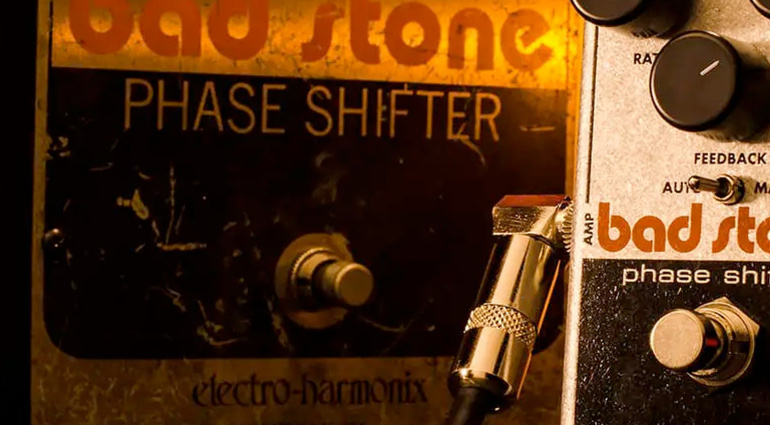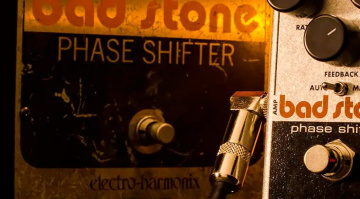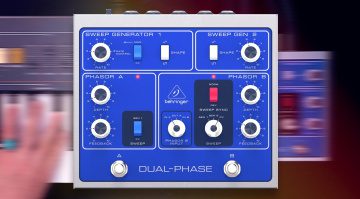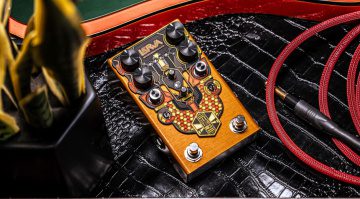Best Phaser Pedal Guide: From Affordable Effects to Classics and Beyond
From Phase 90 to Small Clone and more!
Looking for the best phaser pedal to add instant movement and vintage swirl to your sound? This effect can go from subtle shimmer to massive jet-plane whoosh. So, which one is the best? The most affordable? The most insane-sounding one? Let’s take a look.
Our Picks for Best Phaser Pedal
It’s Not Just a Phase: How Did We Get Here?
The earliest example of the phaser effect can be found in the late 1960s, initially as a studio modulation trick (most often via tape phasing) before being miniaturized into a pedal format. For instance, the early rack unit, the Maestro PS-1, is among the first dedicated phaser/shifter devices. By the early to mid-1970s, foot-pedal versions such as the MXR Phase 90 (introduced in 1974) and the Electro‑Harmonix Small Stone (also 1974) made the effect both inexpensive and portable.
The way these pedals created the phasing effect was by splitting the signal into dry and phase-shifted paths, applying one or more all-pass filters modulated by an LFO, and recombining, which resulted in the characteristic sweeping “whoosh” sound. Over subsequent decades, the phaser design kept evolving (more stages, stereo outputs, deeper feedback, hybrid analog/digital circuitry), and the phaser became a staple in rock, funk, ambient, and experimental rigs.
You can hear the phaser effect in some of the most famous rock songs. Take Jimi Hendrix, for instance. He used a Uni-Vibe-style phaser on tracks like “Machine Gun”. Eddie Van Halen famously used the MXR Phase 90 on “Ain’t Talkin’ ‘Bout Love” (and on loads of other tracks) to get that jet-plane swoosh sound on his guitar. Even beyond classic rock, there are numerous genres that utilize phasers, in many tracks by Daft Punk, for instance. Let’s move on to the considerations you might want to make when looking got the best phaser pedal.
The Best Phaser Pedal: What to look for
When looking for the best phaser pedal, consider how and where you’ll use it. The number of stages (typically 2, 4, 6 or 8) has the biggest impact on the tone. Fewer stages create a more gentle, watery shimmer, while more stages produce that deep, swirling jet-plane effect.
Additionally, consider whether you prefer an analog circuit for a classic, warm sound or a digital design for stereo width, preset storage, and precise modulation control. Additionally, think about where in your pedal chain you would like to place the phaser. Some phasers work better than others, depending on whether they come before or after distortion.
Furthermore, when you’re looking for the best phaser pedal, think about additional features you might need. Having tap tempo, expression inputs, envelope or ramp modes, and MIDI support can really open up the possibilities, especially for live performers. Size and layout matter, too.
As always, this list of the best phaser pedals is purely ranked by price. In addition, we’re solely focussing on singular phaser pedals and excluding bigger modulation units that also offer flanger and chorus effects.
Harley Benton Vintage Phase
First up, the Harley Benton Vintage Phase. With just a single Speed control and true-bypass switching, this phaser pedal is as simple and affordable as it gets. You just dial in how fast the sweep is, engage the effect, and your signal path remains unaffected when off.
In practice, the Vintage Phase is made for budget rigs or players seeking a no-frills phaser tone without extra bells and whistles. If it’s just the occasional phaser effect you want to engage and your pedalboard is crammed, take a look at this one at Thomann*.
Electro Harmonix Nano Small Stone and Bad Stone
The Electro-Harmonix Nano Small Stone and Bad Stone represent two generations of analog phasing from one of the effect’s pioneers. The Nano Small Stone* delivers that unmistakable 1970s swirl in a compact, one-knob format. It’s a plug-and-play choice for players seeking a warm, vintage-style modulation sound that remains among the best phaser pedals available today.
The Bad Stone builds on this legacy with six stages of phasing and controls for rate, feedback, and manual sweep. Plus, its Auto/Manual switch allows both classic whooshing motion and static filter effects, so it’s a more versatile affair. Check it out at Thomann*.
Behringer Dual-Phase and BM-13
The Behringer Dual-Phase* is an analog recreation of the highly sought-after Maestro Phase Shifter PS-1 from the 1970s. With dual sweep generators, extensive CV control, and true stereo operation, it makes quite a statement in this price range. Independent Rate, Depth, and Feedback controls for each phasing effect allow you to create anything from subtle motion to complex, interlocking modulation.
The Behringer BM-13 Phaser continues the tradition of analog emulation by capturing the essence of the Moog MF-103. With its 6- or 12-stage operation, envelope control, and deep modulation parameters, it enables dynamic, evolving sweeps that far surpass the capabilities of the most phaser effects. The original Moog is still regarded as one of the best-sounding phaser effects of all time, so this one won’t be far behind. However, it is worth mentioning that, at the time of writing this article, the BM-13’s delivery time is still listed as “several months”*, so you might need to be a bit patient.
MXR Phase 90
Each pedal category has its north star. The one brand with the one pedal, most other versions and effects are compared to. Among phaser pedals, this one is it, the MXR Phase 90*. Not only is it one of the first ones to ever hit the market. If you’re into classic rock and arena rock from the seventies and eighties, it’s very likely to be the one phaser pedal you’ll hear on all those records.
One Eddie van Halen made the Phase 90 an essential part of his legendary sound (cue ‘Eruption’). So much so, that MXR has a signature version* of the Phase 90 in its roster. In addition, there is also a 1974 Vintage version* with the design and optics of the original release and a rare 50th Anniversary Phase 90 Gold* edition. There are pros and cons to whether the Phase 90 is the best phaser pedal on the market. But it’s certainly the most famous one.
Warm Audio Jet Phaser
The Warm Audio Jet Phaser is based on the similarly named Roland Jet Phaser from the seventies. That one was famous for mixing phaser sounds with fuzz tones. It includes six different modes (two pure Phase and four Jet modes) with controls for Level, Resonance, and Slow Rate, and a Fast/Slow footswitch. With that, the pedal allows you to create that vintage “ramp-up” motion reminiscent of a rotary speaker.
Compared to other candidates for best phaser pedals, the Jet Phaser is a substantial piece of hardware. And with its true bypass design, high build quality, and 18-volt headroom, it handles everything from clean guitar to synth or bass input. Plus, it’s got vintage optics. Take a look at it at Thomann*.
Boss PH-3
The Boss PH-3 Phase Shifter* combines vintage analog character with modern versatility. It offers seven different phasing modes, ranging from classic 4- and 8-stage phasing to more contemporary multi-stage and step effects. Given how popular its predecessors, the PH-2 and PH-2R, were, you can be sure to play one of the best phaser pedals on the market.
With controls for Rate, Depth, Resonance, and Stage/Mode, plus tap-tempo functionality, the pedal provides far more rhythmic and textural control than most compact phasers. The PH-3 can emulate smooth, vintage sweeps or push into pulsing, almost sequenced territory, which makes it ideal for both guitarists and synth users looking to expand their sonic range.
EarthQuaker Devices Grand Orbiter V3
The EarthQuaker Devices Grand Orbiter V3 is more of a boutique take on the best phaser pedal concept. Its 4-stage phasing can be switched into true vibrato mode, offering two modulation flavors in one pedal, while the LFO kill switch turns it into a fixed resonant filter for rich, synth-like sweeps.
With three modulation ranges and controls for Resonance, Rate, Depth, and Sweep, the Grand Orbiter is one mighty versatile phaser pedal. It’s ideal for players seeking nuanced analog modulation that responds dynamically to their playing, whether on guitar, bass, or synths. Check it out at Thomann*.
Conclusion
Of course, no list of anything best-of this or best-XY that is ever complete. Which phasers did I miss or overlook for this list? Which ones are your secret weapon?
Let us know in the comments!
*Disclaimer: This post about the best phaser pedal contains affiliate links and/or widgets. When you buy a product via our affiliate partner, we receive a small commission that helps support what we do. Don’t worry, you pay the same price. Thanks for your support!
One response to “Best Phaser Pedal Guide: From Affordable Effects to Classics and Beyond”


 3,0 / 5,0 |
3,0 / 5,0 | 








The old Boss PH1-r is head and shoulders above the PH-3.